[Part 15]
[Benton Bradberry’s 2012 book, “The Myth of German Villainy” is a superb, must-read, revisionist look at how the German people have been systematically, relentlessly and most importantly, unjustly vilified as the arch criminal of the 20th century. Bradberry sets out, coolly and calmly as befits a former US-Navy officer and pilot, to show why and how the German people have been falsely accused of massive crimes and that their chief accuser and tormenter, organized jewry is in fact the real party guilty of monstrous crimes against Germans and the rest of the world.
In Part 15, the fulfillment of Hitler’s dream of uniting Austria with Germany; the subsequent revival of the Austria economy; and the situation with Austria’s jews pre and post “Anschluss” are described.
Austria was a creation of the Paris Peace Treaty and subsequent Versailles Treaty that forbade it from joining up with Germany to prevent Germany from becoming too powerful again. As it became more and more clear that Austria was not an economically viable state, popular support for union with Germany steadily increased and by the early 1930s popular support for union among both the German and Austrian populations was overwhelming.
Jews were mainly resident in the capital Vienna and dominated it through the Social Democratic Party in the early 1930s. By 1932 Englebert Dollfuss, the leader of the Christian Social Party, became the Austrian Chancellor and along with the Social Democratic Party opposed “Anschluss”. The Christian Social Party was now in a four way struggle with the Nazis, the Communists, and the Social Democrats and after a brief civil war the Nazi Party was banned and its leaders thrown in jail.
By 1938 Seyss-Inquart, the Nazi Minister of the Interior, became Chancellor, and the Nazi Party now controlled the government in Austria. When rioting broke out all over Austria over the issue of unification with Germany, Seyss-Inquart sent a request to Hitler to send in German troops to restore order. On the morning of March 12, the German 8th Army crossed into Austria. They faced no resistance whatever, but were greeted by crowds of cheering Austrians instead. The Anschluss was made immediately effective, subject to ratification by a plebiscite, which was passed with a 99% “yes” vote.
Prior to the Anschluss (union), Austria’s economy was in a catastrophic condition with nearly a third of Austrians out of work. The economy improved dramatically resulting in the Austrians seeing Hitler as a miracle worker.
Once Austria had been incorporated into the Reich, Germany’s laws automatically became Austria’s laws, including the Nuremberg Race Laws. The intent of the Nuremberg Laws, as well as the other anti-Jewish laws, was to break the Jewish grip on the economic, cultural, and social life of Germany and to encourage Jewish emigration. By 1940 Austria’s jewish population was down to 40,000 from 192,000
— KATANA.]
NOTE: The author has very generously given me permission to reproduce the material here — KATANA.
The book can be bought at Amazon here: The Myth of German Villainy
The Myth of
German Villainy
by
Benton L. Bradberry
Contents
[Clicking on a link in the Contents here will take you to that Part, in a separate post]
[Part 01]
Chapter 1 – The Myth of Germany as an Evil Nation
Germany’s Positive Image Changes Overnight
[Part 02]
Chapter 2 – Aftermath of the War in Germany
The Versailles Treaty
Effect of the Treaty on the German Economy
Was the War Guilt Clause Fair?
Did Germany Really Start the War?
[Part 03]
Chapter 3 – The Jewish Factor in the War
Jews at the Paris Peace Conference
Jews in Britain
[Part 04]
Chapter 4 – The Russian Revolution of 1917
Bolsheviks Take Control
Jews and the Russian Revolution
Origin of East European Jews
Reason for the Russian Pogroms Against the Jews
Jews Leave Russia for America
Financing the 1917 Revolution
Jews in the Government of Bolshevik Russia
[Part 05]
Chapter 5 – The Red Terror
Creation of the Gulag
Bolsheviks Kill the Czar
Jews as a Hostile Elite
The Ukrainian Famine (Holodomor)
[Part 06]
Chapter 6 – The Bolshevik Revolution Spreads Throughout Europe
Jews in the Hungarian Revolution
Miklos Horthy Saves Hungary
Jews in the German Revolution
The Spartacist Uprising in Berlin
Jewish Bolsheviks Attempt to Take Italy
Jewish Bolsheviks Attempt to Take Spain — The Spanish Civil War
Czechoslovakia in Danger of Communist Takeover
The Comintern’s Aim? World Domination!
[Part 07]
Chapter 7 – The Nation of Israel
History of the Expulsion of Jews
[Part 08]
Chapter 8 – Jews in Weimar Germany
Jews Undermine German Culture
[Part 09]
Chapter 9 – Hitler & National Socialists Rise to Power
The 25 Points of the National Socialist Party
[Part 10]
Chapter 10 – National Socialism vs. Communism
National Socialism
Jews Plan Marxist Utopia
[Part 11]
Chapter 11 – Jews Declare War on Nazi Germany
Text of Untermeyer’s Speech in New York
The Jewish Persecution Myth
Effect of Boycott on the German Economy
Jewish Exaggerations are Contradicted by Many
[Part 12]
Chapter 12 – The Nazis and the Zionists Actually Work Together for Jewish Emigration out of Germany
The Nuremberg Laws – 1935
The Zionist Movement
[Part 13]
Chapter 13 – Life in Germany Under Hitler
Night of the Long Knives
1934 Annual Nazi Rally at Nuremberg
Hitler Revives the German Economy
Hitler Becomes the Most Popular Leader in the World
[Part 14]
Chapter 14 – Hitler Begins Reclamation of German Territory
Chapter 15 – The 1936 Olympics
[Part 15]
Chapter 16 – “Anschluss”. The Unification of Austria and Germany
Austrian Economy Revived
Austria’s Jews
[Part 16]
Chapter 17 – Germany Annexes the Sudetenland
[Part 17]
Chapter 18 – War with Poland
The Polish Problem
Hitler’s Proposal to Poland
Kristallnacht
German-Polish Talks Continue
Jews Influence both Roosevelt and Churchill
British and American Political Leaders Under Jewish Influence
Roosevelt’s Contribution to Hostilities
Lord Halifax Beats the War Drums
Germany Occupies Bohemia and Moravia
Roosevelt Pushes for War
Anti-war Movement Becomes Active
Poles Murder German Nationals Within the Corridor
[Part 18]
Chapter 19 – The Phony War
Russo-Finnish War
The Norway/Denmark Campaign
German Invasion of Denmark and Norway
Churchill Takes Chamberlain’s Place as Prime Minister
[Part 19]
Chapter 20 – Germany invades France Through the Low Countries
The Phony War Ends.
Churchill the War Lover
The Fall of France
Hitler Makes Peace Offer to Britain
[Part 20]
Chapter 21 – The Allied Goal? Destruction of Germany!
[Part 21]
Chapter 22 – Germany as Victim
Rape and Slaughter
Jewish Vengeance
The Jewish Brigade
[Part 22]
Chapter 23 – Winners and Losers
Chapter 16
“Anschluss” The Unification
of Austria and Germany
Beginning with his 25 Points speech of 1919, one of Hitler’s overriding goals was the unification of all German people into a single nation-state. Hitler was an Austrian, but always called himself a German, and he considered Austria to be part of Germany. The giant multi-ethnic Austro-Hungarian Empire had been dismembered after World War I by the Paris Peace Conference and Austria was left as a small rump state of 6.8 million people, mostly ethnic Germans. As part of the Austro-Hungarian Empire, Austria had been an integral part of a relatively self-sufficient economic system, but now, having been carved out of that giant empire and made into a tiny independent state, Austria was no longer an economically viable entity. She had been cut off from sources of raw materials which had been available to her from the Austro-Hungarian Empire, and also from markets for export. Austria was a German speaking, German state, and it would have been only logical for Austria to combine with Germany after the Austro-Hungarian Empire no longer existed. Moreover, there was strong support for that in both Austria and Germany, but the Versailles Treaty specifically forbade it. World War I had been fought primarily to reduce the size and power of Germany, and the Versailles Treaty was designed to prevent Germany from ever becoming a super power again. For that reason, the victors of the war were steadfastly opposed to the union of Austria with Germany.
As it became more and more clear that Austria was not an economically viable state, popular support for union with Germany steadily increased. By the early 1930s popular support for union among both the German and Austrian populations was overwhelming. It was estimated that at least 80 percent of the Austrian people favored unification with Germany, and nearly as high a percentage of Germans also favored it. As a preliminary measure, an attempt was made in 1931 to create a customs union between Austria and Germany to permit free trade and unrestricted travel between the two countries, but the agreement was blocked by outside forces, notably France and Czechoslovakia, who saw it as an attempt to circumvent the Versailles Treaty. With a 25% unemployment rate and a starving population, Austria was desperate to find a means of increasing trade and productivity, but all such attempts were blocked by these outside forces. Union with Germany would have solved all of Austria’s problems, and it would also have partially fulfilled the aspirations of the National Socialists for a single German state.
Austria was politically divided during this period by a struggle between left wing and right wing groups. Traditional, mostly rural Austrians, along with the bourgeoisie, supported the conservative, Catholic Christian Social Party (CS), while the workers and labor unions, mainly in the cities, supported the Social Democratic Party. The Communist Party (KPO) and the National Socialist Party (Nazi) were marginal groups at first. The Communist Party was composed mostly of Jews, but it was small and failed to gain traction in Austria as it had in Germany. Most of Austria’s Jews belonged to the Social Democratic Party, and most of these Jews were avowed Marxists. The leader of the party, Otto Bauer, was a Jew, and Jews filled all of the leadership positions in the party, though the rank and file were mostly Austrian laborers and members of Jewish led labor unions.
[Add. image — Otto Bauer (5 September 1881 – 4 July 1938), the jewish leader of the Social Democratic Party. Bauer died of heart failure in Paris on 4 July 1938, aged 56, just four months after Austria had become part of the Nazi Third Reich.
His sister, Ida Bauer, was a patient of Sigmund Freud, who published a famous case study about her using the pseudonym Dora.]
During the early 1930s, 192,000 Jews were resident in Austria, almost all of them in Vienna. Jews represented 2.8 percent of the Austrian population, but nearly 10 percent of the population of Vienna. The population of Vienna was just under 2 million. Despite their small numbers, Jews totally dominated the capital city. Jews owned two thirds of all newspapers and banks. They owned 60 percent of all large businesses and industries. Over 50% of lawyers, doctors and dentists in Vienna were Jewish, and nearly a third of university professors were Jewish.
Through their control of the Social Democratic Party, Vienna’s largest party, Marxist Jews dominated the city government of Vienna, giving it the reputation of “Red Vienna.” They held a majority of seats on the City Council, and they controlled the labor unions. The Jewish controlled Social Democratic Party was traditionally anti-clerical and given to anti-religious rhetoric, which the Catholic clergy used to label them “godless, Jewish-Bolshevists.”
[Add. image — Englebert Dollfuss, Chancellor of Austria here in Geneva in 1933. Having served as Minister for Forests and Agriculture, he ascended to Federal Chancellor in 1932 in the midst of a crisis for the conservative government. In early 1933, he shut down parliament, banned the Austrian Nazi party and assumed dictatorial powers.]
The conservative Christian Social Party (CS), which had the support of the Catholic Church in Austria, managed to gain control of the Austrian government in 1932 through a coalition with other conservative parties. It’s leader, Englebert Dollfuss, became the Austrian Chancellor. While the Jewish dominated Social Democratic Party (SDP) controlled the government of Vienna, the Christian Social Party (CS) controlled the national government.
By this time, a branch of Germany’s Nazi party had established itself in Austria. The members wore the same uniforms as their German colleagues and adhered to the same doctrines of anti-Marxism and anti-Semitism. They were recruited mainly from the lower bourgeoisie and the peasantry and their main political goal was the union of Austria and Germany. The movement grew slowly and no Nazi had as yet managed to get elected to the national parliament. In the provincial elections of 1932, however, the Nazis won a number of seats in several of the local diets.
After Hitler became Chancellor in Germany in 1933, the Austrian Nazis, led by Dr. Alfred Frauenfeld, began immediately to concentrate their energies to bring about Anschluss, or union with Germany. The Austrian Nazis considered themselves a part of the Nazi movement in Germany, and took their orders from Hitler.
Though Dollfuss had previously favored Anschluss, he changed his mind and decided that the best path for Austria was independence. Dollfuss was a devout Catholic and he wanted to build up an alternative to Nazism — a Catholic, anti-socialist, authoritarian, Austrian movement. He was supported in his opposition to Anschluss by the Social Democratic party under Jewish, Marxist control, but he wanted nothing to do with them either. He was as much opposed to the Reds as to the Nazis.
The Christian Social Party was now in a four way struggle with the Nazis, the Communists, and the Social Democrats. In order to assert control, the Dollfuss regime dissolved parliament, banned the Austrian Nazi and Communist parties, and centralized power in the office of the Chancellor who now had dictatorial powers to rule the country. Many of the Nazi leaders were thrown in jail. A brief civil war ensued in which the Dollfuss government was victorious. A concordat was soon announced with the Holy See (the Pope), which essentially made Catholicism the official religion of Austria.
Dollfuss didn’t last long, however. He was soon assassinated by the Nazis in a failed coup attempt as the political struggle in Austria continued. Kurt Schuschnigg, who succeeded Dollfuss as Chancellor, made up his mind to destroy the Austrian Nazis and immediately began to initiate actions against them, including rounding them up and locking them up in internment camps. The oppressive Schuschnigg regime was not popular with the Austrian people, the majority of whom actually favored the Nazis because the Nazis supported union with Germany. The Christian Social Party (CS) under Schuschnigg, which now controlled the national government, and the Social Democratic Party (mostly Jewish) which now controlled the government of Vienna, became strange bedfellows as they united in their opposition to union with Germany, though in little else.
The Austrian people, on the other hand, were 80 percent in favor of unification with Germany.
On February 12, 1938, Hitler summoned Schuschnigg to his villa at Berchtesgaden in Bavaria to discuss Schuschnigg’s problems with the Austrian Nazis. During the meeting, Hitler was very condescending toward the Austrian Chancellor, and virtually instructed him to lift the ban on political parties in Austria, to reinstate full party freedoms, to release all imprisoned members of the Nazi Party and to permit them to participate in the government. When Schuschnigg indicated reluctance to comply with these instructions, Hitler threatened military action. Schuschnigg had no choice but to comply, as Austria’s military power was no match for that of Germany. Moreover, Austrian public opinion was against the Austrian Chancellor.
After returning to Austria, Schuschnigg, in compliance with Hitler’s instructions, appointed Arthur Seyss-Inquart, a lawyer and member of the Nazi Party, as Interior Minister. He also removed General Alfred Jansa as Chief of Staff of the Austrian Army, also at Hitler’s instruction, because Jansa had expressed his intention to resist any attempted German entry into Austria by armed force. Hitler wanted to avoid any such confrontation at all costs.
But safely away from Hitler’s intimidating presence, Schuschnigg began reverting back to his recalcitrant position on union with Germany and continued to oppose it. He also continued his oppressive measures against the Austrian Nazi Party which advocated union with Germany. The mostly Jewish Social Democrats agreed on very little with the Christian Socialists, but they turned out in force to support Schuschnigg in opposition to union with Germany. Groups of these Social Democrats (mostly Jews) went all around the city of Vienna painting slogans on the sidewalks and on the walls of buildings in support of Austrian independence and against Austrian union with Germany. Austria’s Jews vehemently opposed Hitler and the Nazis, including Austrian Nazis, and they wanted nothing to do with Hitler’s Germany, certainly not union with it. This put them in direct opposition to the Austrian people and served only to inflame the already rampant anti-Semitism in Austria.
In contravention of Hitler’s instructions Schuschnigg immediately announced a plebiscite (a national vote) to be held on Austria’s Independence day of March 13, 1938, to determine whether or not Austria would unite with Germany. He then set out on a tour of Austria to try to whip up patriotic feelings and to persuade the Austrian people to vote for an independent Austria, and against union with Germany.
Schuschnigg’s plebiscite was to be open to all Austrian voters, but was to be restricted only to those over the age of 24. It was Austria’s youth — those under 24 years of age — who were most overwhelmingly in favor of union with Germany. Various other devices were also to be employed to stack the vote against union with Germany. One device he used to influence the vote was to write the wording of the plebiscite in a confusing way so that the voters would be voting for independence while believing they were voting for unification.
Arthur Seyss-Inquart, (L) with Hitler, replaces Kurt Schuschnigg (R) as chancellor of Austria.
Hitler was furious with Schuschnigg and declared that he would not permit the plebiscite to go forward under those circumstances. Hitler described Austria as:
“A country which for many years had no elections at all, where there were no means of determining who were qualified to vote, and then announces an election which is to take place in less than three and a half day’s time. There are no lists of voters,” Hitler said, “there are no voting cards, there are no means of testing a person’s right to vote, there is no obligation to maintain the secrecy of the ballot, there is no guarantee that the election will be conducted with impartiality, there is no security that the votes will be properly counted – and so on.”
Hitler sent an ultimatum to Schuschnigg on March 11, demanding that he step down as Chancellor and hand over all power to the Austrian National Socialists (Nazis), or face invasion. Unable to gain support from either Italy, France or Britain, and with little support from the Austrian people, Schuschnigg resigned as Chancellor. Seyss-Inquart, the Nazi Minister of the Interior, then became Chancellor, and the Nazi Party now controlled the government in Austria.
Rioting had broken out all over Austria over the issue of unification with Germany, so the new Chancellor, Seyss-Inquart, sent a request to Hitler to send in German troops to restore order. Whether they were actually needed or not is not clear, but this was the necessary pretext for German troops to enter Austria. The next day, on the morning of March 12, the German 8th Army crossed into Austria. They faced no resistance whatever, but were greeted by crowds of cheering Austrians instead.
Hitler entered Austria by car in the afternoon of the same day. His first stop was at Braunau, his birthplace. In the evening he entered Linz where he grew up. At both stops, he received an overwhelming reception.
Hermann Goering, who had accompanied Hitler into Austria, made a telephone call that evening back to party officials in Germany, and stated:
“There is unbelievable jubilation in Austria. We ourselves did not think that sympathies would be so intense.”
Hitler then made a triumphal tour through Austria which ended in Vienna. A huge crowd totalling more than 200,000 filled the Heldenplatz (Heroes Square) in Vienna to hear him proclaim that Austrian was now a part of Germany.
“This is the moment of the greatest accomplishment of my life,” he said. “The German Reich, as it stands today, can never be broken by anyone again.”
The Anschluss was made immediately effective, subject to ratification by a plebiscite. Following proper registration of Austria’s voting population, elections were held in both Germany and Austria on April 10, 1938. The Anschluss was approved by the Austrian people with a 99.75% “yes” vote, and by the German people with a 99.2 % “yes” vote.
[Add. image — Austrian “Anschluss” (union) with Germany, March 12, 1938. The Sudetenland territory was re-united with Germany at the end of September, 1938.]
Hitler wrote in Mein Kampf, “People of the same blood should be in the same Reich.”
Austrians cheer as German troops enter.
Hitler is warmly greeted as he enters Austria.
Hitler enters Vienna.
Austrians are overjoyed by arrival of German troops.
Cardinal Theodor Innitzer, a political figure in the Austrian Christian Social Party (CS) declared on March 12:
“The Viennese Catholics should thank the Lord for the bloodless way this great political change has occurred, and they should pray for a great future for Austria. Needless to say, everyone should obey the orders of the new institutions.”
Robert Kauer, President of the Protestants in Austria, greeted Hitler on March 13, as;
“saviour of the 350,000 German Protestants in Austria and liberator from a five-year hardship.”
Karl Renner, Austria’s first post-war chancellor in 1918, announced his support for the Anschluss and appealed to all Austrians to vote in favor of it on April 10.
“Hitler had a plausible case to argue when he claimed that the Anschluss was only the application of the Wilsonian principle of self-determination.” — Alan Bullock. Historian.
“The crisis of March, 1938 (which led to the Anschluss) was provoked by Schuschnigg, the Austrian Chancellor, not by Hitler.” — A.J.P.Taylor. British historian.
“He (Chamberlain) had no difficulty in recognizing where this injustice lay. There were six million Germans in Austria to whom national reunification was still forbidden by the Peace Treaties of 1919. Three million Germans in Czechoslovakia whose wishes had never been consulted; three hundred and fifty thousand people in Danzig who were notoriously German.” — A.J.P.Taylor. British Historian.
“The German Army was invading Austria, or rather was marching in to the general enthusiasm of the people.” – A.J.P.Taylor, British historian.
“The pull of sentiment, language and history, reinforced by the material advantages offered by becoming part of a big nation, was strong enough to waken a genuine welcome when the frontier barriers went down and the German troops marched in garlanded with flowers…. there was a widespread sense of relief, even amongst those who were far from being Nazis.” — Alan Bullock. Historian.
As might have been expected, Jewish writers took a different view. The Jewish historian William L. Shirer, in his book The Rise and Fall of the Third Reich, calls the Anschluss “the rape of Austria.”
[Add. image — jewish journalist William L. Shirer (1904 – 1993) with his 1960 book, The Rise and Fall of the Third Reich ]
Hitler later commented:
“Certain foreign newspapers have said that we fell on Austria with brutal methods. I can only say: even in death they cannot stop lying. I have in the course of my political struggle won much love from my people, but when I crossed the former frontier (into Austria) there met me such a stream of love as I have never experienced. Not as tyrants have we come, but as liberators.”
Austrian Economy Revived
Prior to the Anschluss, Austria’s economy was in a catastrophic condition with nearly a third of Austrians out of work. Just across the border in Germany, unemployment had been eliminated, living standards and working conditions had vastly improved, and economic, social and cultural life was flourishing again. Before Hitler became Chancellor, economic conditions in Germany had been the same as Austria’s.
Following Austria’s incorporation into the Reich, conditions also improved dramatically in Austria. Within six months after Anschluss, the total number of unemployed was reduced from 401,000 to only 99,865. By 1940, the unemployment rate in Austria was only 1.2 percent.
By the end of 1938, during which the Anschluss occurred, the weekly income of industrial workers in Austria rose 9 percent. The Austrian GNP experienced a 12.8 percent growth rate in 1938, and 13.3 percent in 1939. Seldom in history has a country experienced such rapid, dramatic economic growth.
Shortly after the Anschluss, Germany’s National Labor Law and its comprehensive social security system were introduced in Austria. Basic rights in the workplace were thereby guaranteed, and workers were protected from arbitrary dismissal. By these measures, relief was also quickly provided to more than 200,000 desperately poor people, and health care benefits were extended to the working class. A large-scale construction program was immediately launched to provide affordable housing. Cultural life was greatly encouraged, with energetic promotion of music, the fine arts and literature. The result of all of this was an increase in prosperity and optimism, but also a jump in the Austrian birthrate. The Austrian people believed that union with Germany was the best thing that ever happened to Austria, and they believed that Hitler was a miracle worker.
According to Professor Evan Burr Bukey of the University of Arkansas, in his book, “Hitler’s Austria,”:
“Hitler enjoyed a frenzied acclimation among the Austrian people seldom seen since the days of the Caesars.”
Austria’s Jews
In 1938, prior to the Anschluss, 192,000 Jews lived in Austria, almost all of them in Vienna, a city of nearly 2 million. In spite of their relatively small numbers, Austria’s Jews wielded vast and disproportionate wealth and power. For this reason, and all the other reasons that Jews have been universally despised by their host populations, Austrian Jews were extremely unpopular with the Austrian people.
Professor Evan Bukey wrote:
“The predominant position of the Jews in an impoverished country only intensified the fear and loathing of the Austrian masses. As we have already seen, Jewish businesses and financial institutions managed much of the country’s economic life. At the time of the Anschluss three-quarters of Vienna’s newspapers, banks and textile firms were in Jewish hands … The extraordinary success of the Jews in the learned professions also inspired jealously and spite. Over 50 percent of Austria’s attorneys, physicians and dentists were Jewish.”
Yet, Jews were only 2.8 percent of the Austrian population. Moreover Jews isolated themselves within a closed society in Austria, with intense in-group cooperation and mutual assistance between themselves, at the total exclusion, and expense, of non-Jewish Austrians. Many of them dressed differently. They were regarded by Austrians as an alien, parasitic elite who exploited non-Jewish Austrians for the benefit of Jews alone.
They also avoided physical work and treated ordinary Austrians with condescension.
According to Professor Bukey, large numbers of Austrians, especially of the Catholic faithful, viewed baptized Jews, as well as all other Jews, with a hatred;
“so tightly woven into the fabric of Austrian society that it constituted a Sorelian political myth, immune to empirical falsification.” (Georges Sorel, a French philosopher averred that “myth” was a powerful motivator in people’s lives.)
Jews on the streets of Vienna prior to Anschluss.
This seething, barely contained hatred of the Jews boiled over on March 11, 1938, as crowds gathered to welcome Hitler into Vienna where he was to announce the Anschluss. Professor Bukey writes that:
“Untold thousands of Viennese took to the streets of their city like mad persons, dragging anyone who “looked Jewish” from vehicles, clubbing and beating victims, desecrating synagogues, robbing department stores, and raiding Jewish apartments. They compelled rabbis to scrub toilet bowls with prayer shawls and stole whatever cash, jewelry, and furs they could find. An SS correspondent would later write admiringly, ‘The Viennese have managed to do overnight what we have failed to achieve in the slow-moving, ponderous north up to this day. In Austria, a boycott of the Jews does not need organizing the people themselves have initiated it.’”
Once Austria had been incorporated into the Reich, Germany’s laws automatically became Austria’s laws, including the Nuremberg Race Laws. The intent of the Nuremberg Laws, as well as the other anti-Jewish laws, was to break the Jewish grip on the economic, cultural, and social life of Germany and to encourage Jewish emigration. After Anschluss, when these laws applied in Austria, the Austrian Jews became disenfranchised overnight. What had taken 5 years to accomplish in this regard in Germany was done within days in Austria.
By March 18 the authorities had closed down the offices of the Jewish community and Zionist organizations in Vienna and sent their officers to Dachau. During the first weeks after the Anschluss, Jews were fired from their jobs in theaters, community centers, public libraries, and universities. Throughout Austria, Jews were arrested and imprisoned.
Local Nazis rounded up Jews in the city of Vienna and forced them to scrub the streets and walls with brushes. The photo below was widely publicized at the time as an example of the cruelty and pointless humiliation Jews in Vienna were subjected to, but there was also a rational explanation for what took place which is not usually reported. Prior to the Anschluss, when Chancellor Schuschnigg was campaigning against Austrian unification with Germany, the Social Democrats in Vienna turned out in large numbers to support him. Most of Vienna’s Jews belonged to the Social Democratic Party, and as Jews, they were fervently against union with Germany. International Jewry, after all, was engaged in a “holy war” against Germany, which included an economic boycott campaign, and an anti-German propaganda campaign in the international Jewish press. This “holy war” had the enthusiastic support and participation of Austria’s Jews. The last thing Austrian Jews wanted was unification with Germany.
In support of Schuschnigg’s campaign, Jewish Social Democrats painted anti-unification slogans on the sidewalks and walls of buildings throughout the city of Vienna. This angered the non-Jewish Austrians, the vast majority of whom supported unification with Germany. It was the Jews who painted the slogans all over the walls and sidewalks, so it was the Jews who were made to scrub them off. That fact was left out of the international anti-German propaganda. The sidewalk cleaning project may well have been humiliating, but it was not without justification; at least an explanation. But it is also true that the Austrian people took unseemly pleasure in the humiliation of these wealthy and formerly powerful Jews as they were being forced to clean up the sidewalks. Crowds gathered, hissed, and spat abuse at them as they scrubbed.
Jews are forced to clean painted slogans off the sidewalks of Vienna. The slogans had been previously painted on the sidewalks by Jews opposing Anschluss.
At the same time, Jewish stores were plundered by SA men who sometimes (cynically but with a pretense of legality) left a receipt. Jewish businesses were Aryanized, that is, Jewish owners were forced to sell their businesses to Austrians, or Aryans, in transactions that were decidedly one sided and invariably a big financial loss to the Jew. The greed in Vienna ran out of control as Austrians stepped on one another to get at Jewish wealth. The American journalist William Shirer, who was Jewish, witnessed all of this and described it as “an orgy of sadism.”
[Add. image — William L. Shirer (February 23, 1904 – December 28, 1993), left, the bureau chief for CBS radio, at the broadcasting center in Berlin in 1939.]
Jews began leaving Austria in massive numbers. In August 1938 the “Reich Central Office for Jewish Emigration” was set up in the Rothschild palace in Vienna, for the purpose of cutting through the red tape and facilitating rapid Jewish emigration out of Austria. SS Captain Adolf Eichmann was assigned there as one of the administrators. By June 1939 the office had aided in the emigration of 110,000 Austrian Jews. An assembly line process was established through which the Jews passed in one day’s time, relinquishing one document (and piece of property) at every step of the way until the end when he and his family received visas out of the country. Eichmann employed the services of the local Jewish leadership to process this emigration — much of it to Palestine.
[Add. image — The Palais Albert Rothschild was a palatial house in Vienna, one of five Palais Rothschild in the city owned by members of the Rothschild banking family of Austria, a branch of the international Rothschild family. In 1954 the palace was torn down.]
In late June, 1939, the remaining Jews, as well as all non-Jews married to Jews, still working in the private sector, were fired from their jobs and “encouraged” to leave the country. By this time, hundreds of Jewish owned factories and thousands of businesses had been closed or confiscated by the government.
The population of Jews in Germany in 1933 was approximately 500,000, and in Austria, 192,000. By 1940 only 160,000 remained in Germany and 40,000 remained in Austria, for a total of 200,000 in Germany and Austria combined. All the rest had emigrated.
Anschluss could now be checked off of Hitler’s checklist of things he had avowed to accomplish.
[END of Part 15]
______________________________
PDF Notes
* Total words = 6,188
* Total pages = 34
*Total images = 16
*Note: Images not in original book are indicated as “Add. image” (Additional image).
*Text in [square brackets] is not part of the original book.
*Special thanks to reader “mblaine” for providing the text for this book.
======================================
<
div>
Click to download a PDF of this post (4.2 MB).
The Myth of Germany Villainy – Part 15 – “Anschluss” The Unification of Austria and Germany
Click on a link to go to another part:
[Click images to enlarge]
Part 01 — Cover text; About the Author; Preface; Chapter 1: The Myth of Germany as an Evil Nation
Part 02 — Chapter 2: Aftermath of the War in Germany
Part 03 — Chapter 3: The Jewish Factor in the War
Part 04 — Chapter 4: The Russian Revolution of 1917
Part 05 — Chapter 5: The Red Terror
Part 06 — Chapter 6: The Bolshevik Revolution Spreads Throughout Europe
Part 07 — Chapter 7: The Nation of Israel
Part 08 — Chapter 8: Jews in Weimar Germany
Part 09 — Chapter 9: Hitler and National Socialists Rise to Power
Part 10 — Chapter 10: National Socialism vs Communism
Part 11 — Chapter 11: Jews Declare War on Nazi Germany
Part 12 — Chapter 12: The Nazis and the Zionists Actually Work Together for Jewish Emigration out of Germany
Part 13 — Chapter 13: Life in Germany Under Hitler
Part 14 — Chapter 14 & 15: Hitler Begins Reclamation of German Territory; The 1936 Olympics
Part 15 — Chapter 16: “Anschluss” The Unification of Austria and Germany
Part 16 – Chapter 17: Germany Annexes the Sudetenland
Part 17 – Chapter 18: War with Poland
Part 18 – Chapter 19: The Phony War
Part 19 – Chapter 20: Germany invades France – The Phony War Ends
Part 20 – Chapter 21: The Allied Goal? Destruction of Germany!
Part 21 – Chapter 22: Germany as Victim
Part 22 (last) – Chapter 23: Winners and Losers
See also:
The Myth of German Villainy: Author Ben Bradberry Interview — TRANSCRIPT
_____________________
Version History
Version 5: Mar 13, 2021 – Added new Go2 Cover images (3).
Version 4: May 5, 2020 — Re-uploaded images and PDF for katana17.com/wp/ version.
Version 3: Apr 9, 2020 — Updated links to other parts.
Version 2: Jan 6, 2017 — Added one image. Added PDF of post for download.
Version 1: Jan 5, 2017 — Created post.

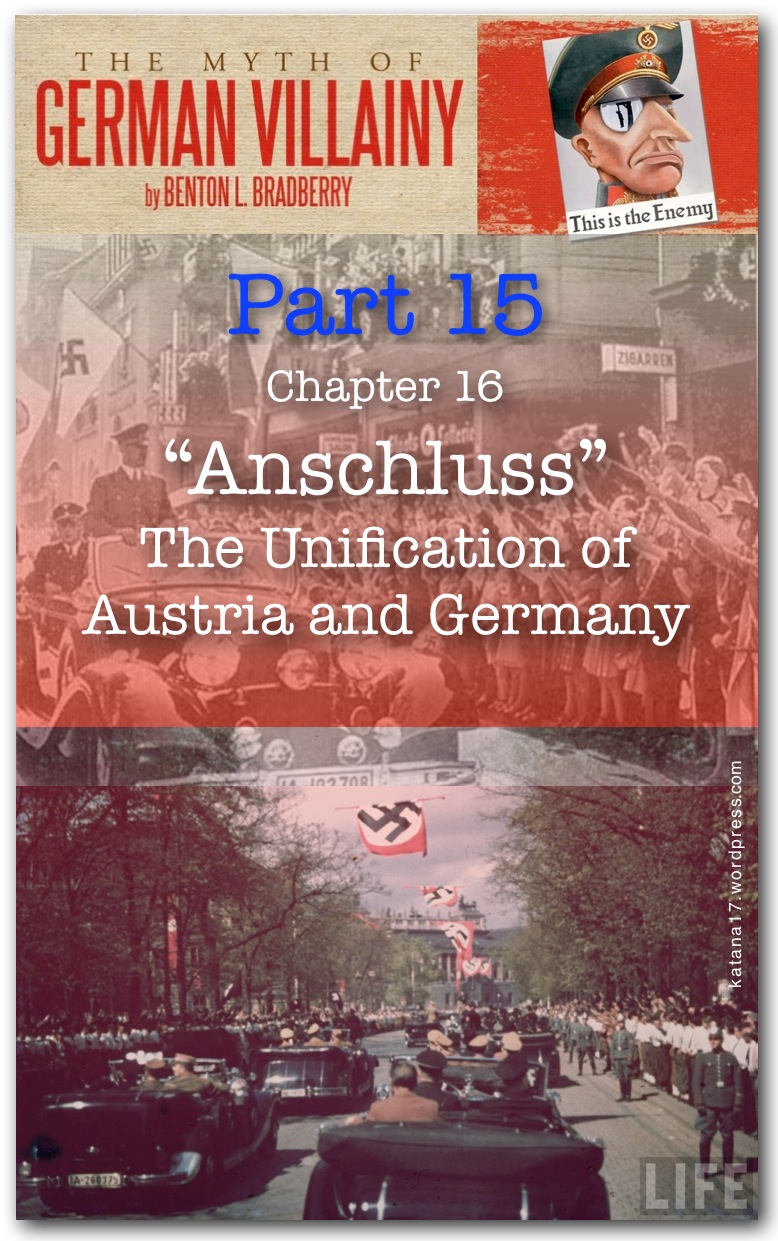
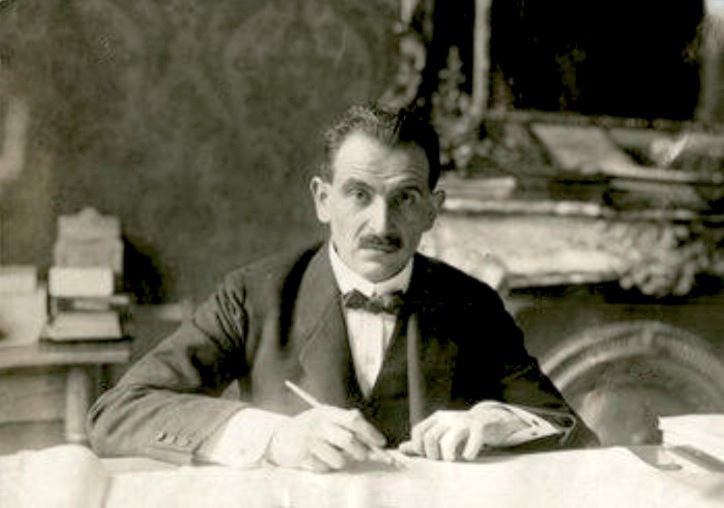



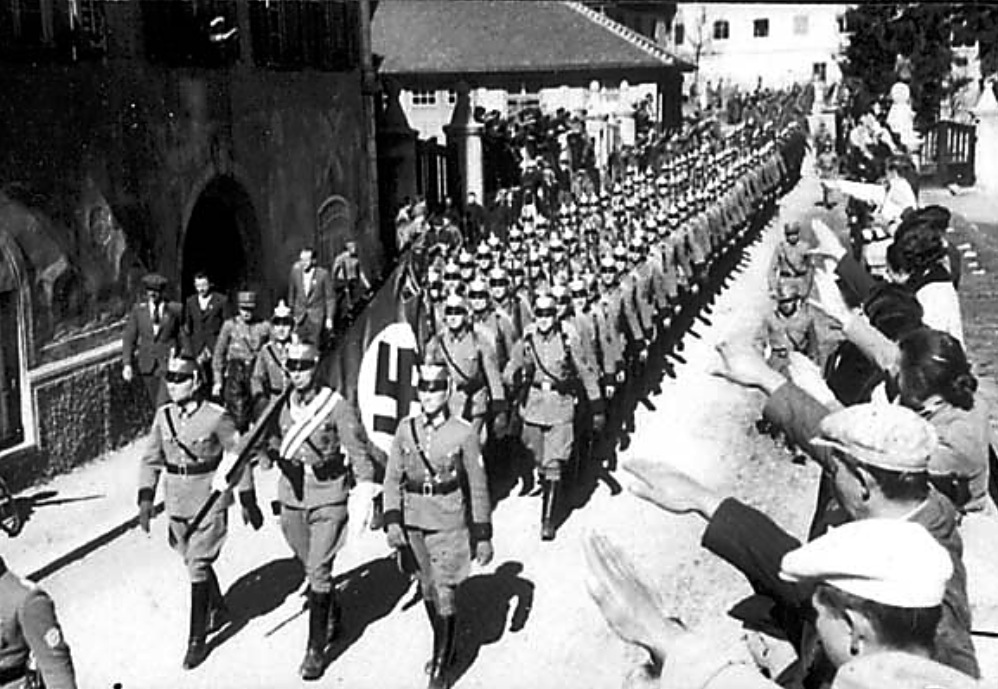

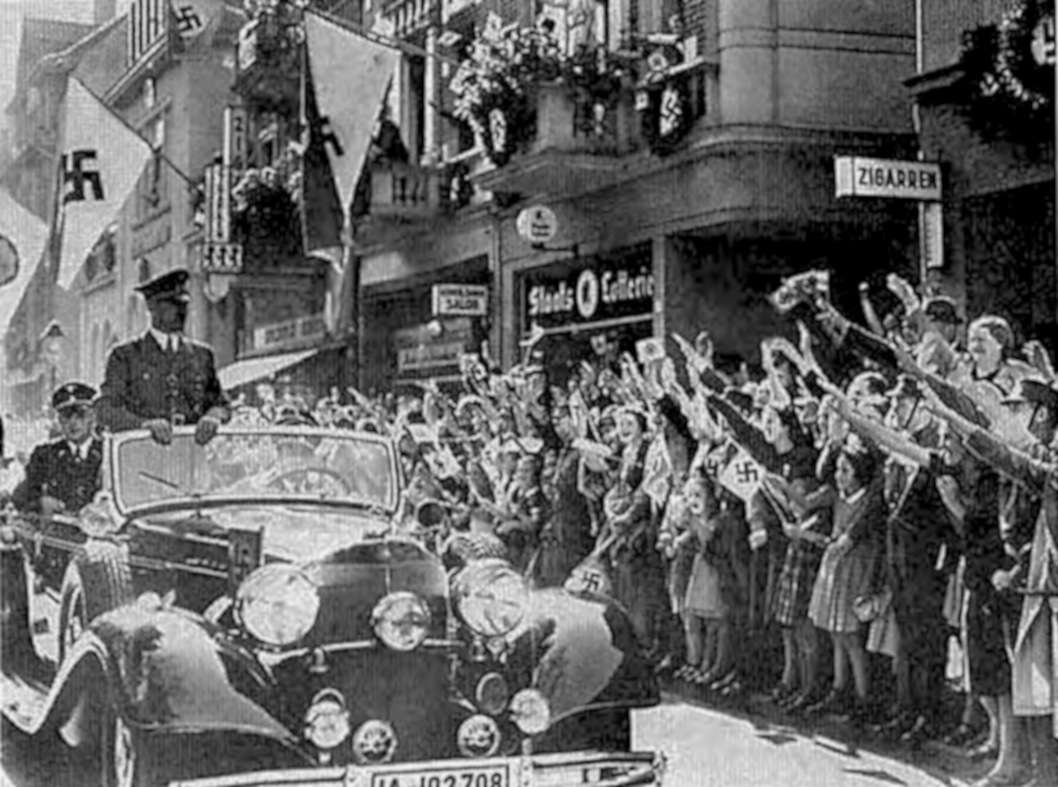
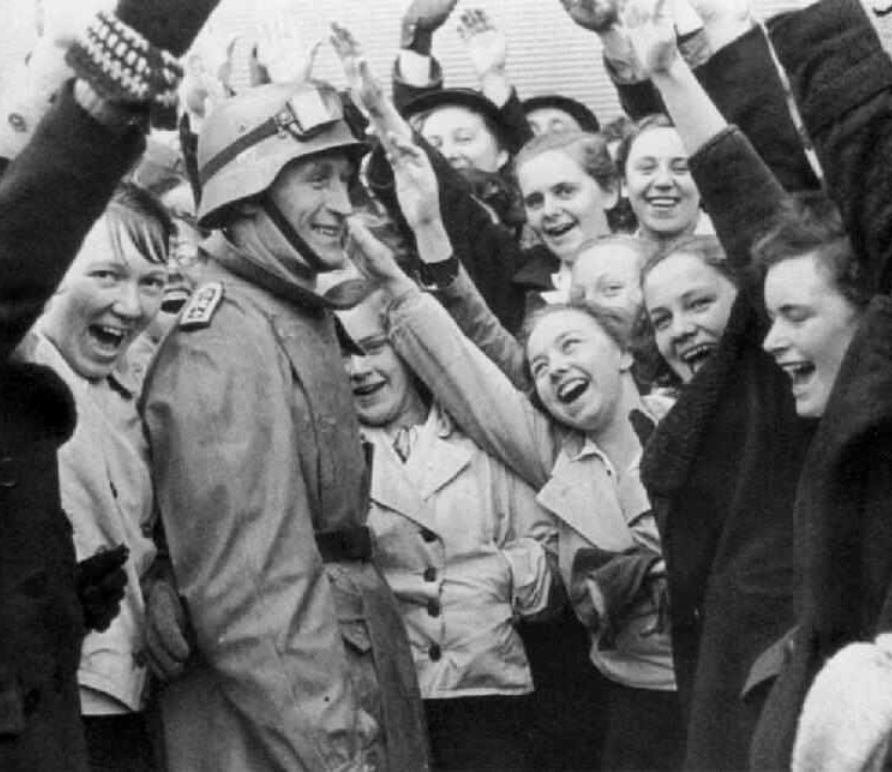
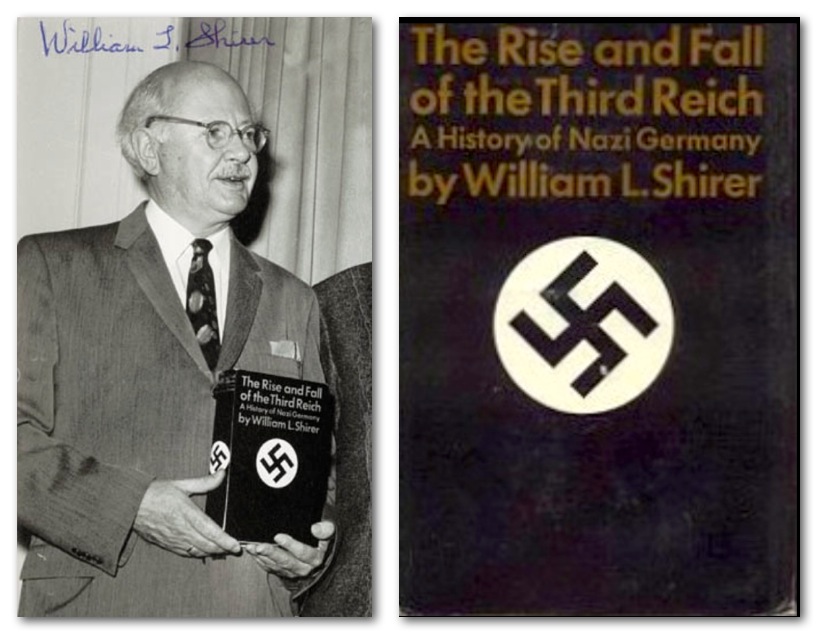
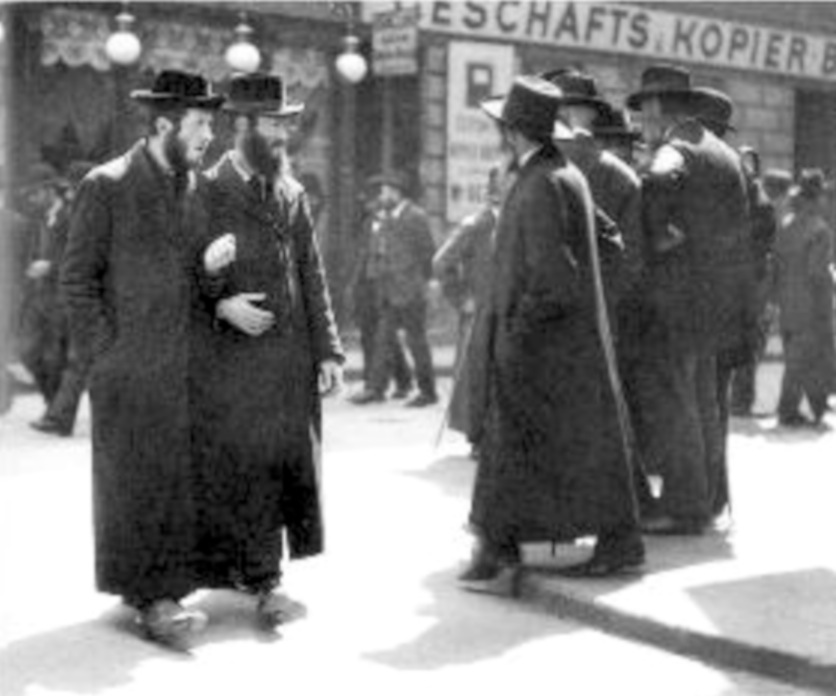
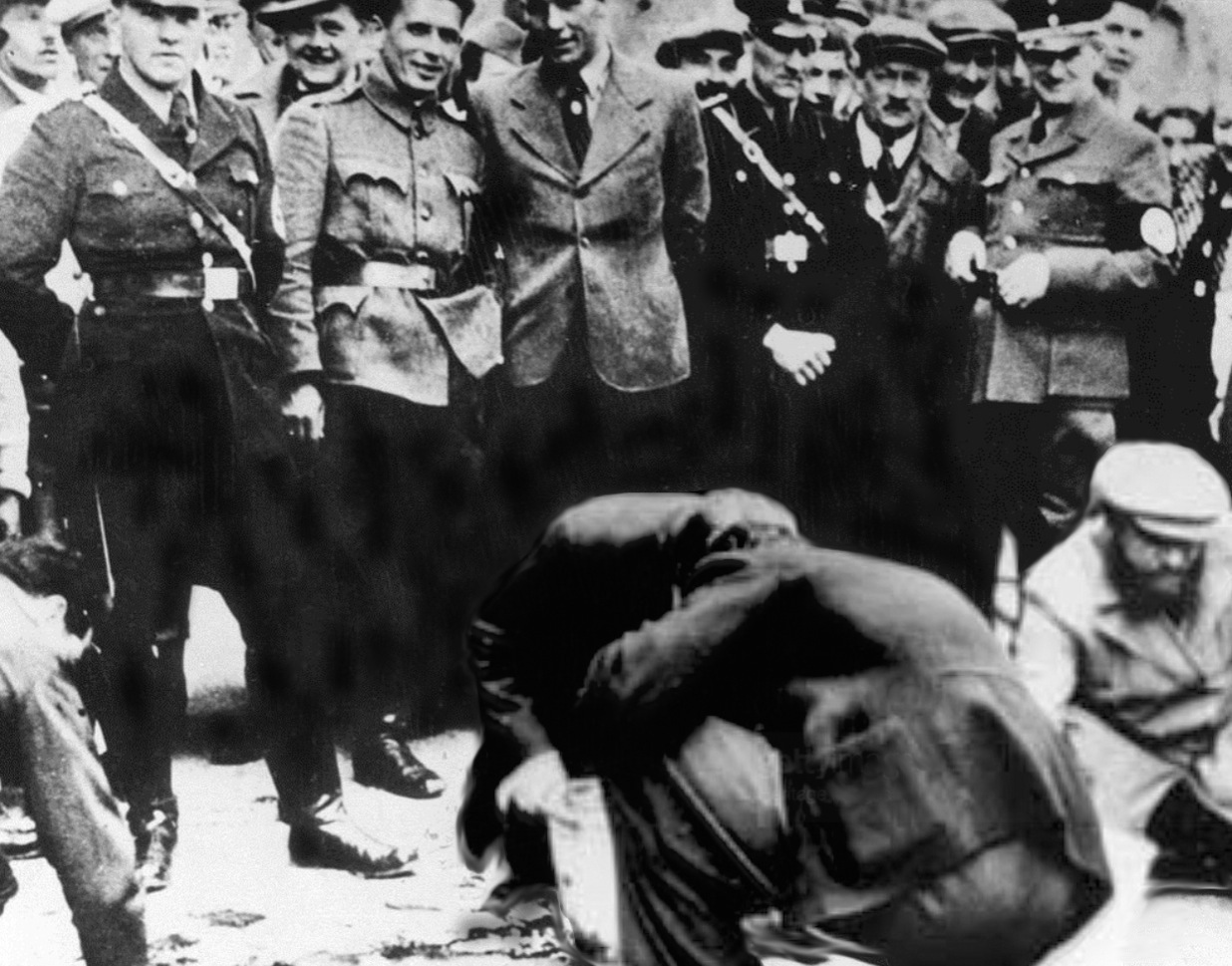
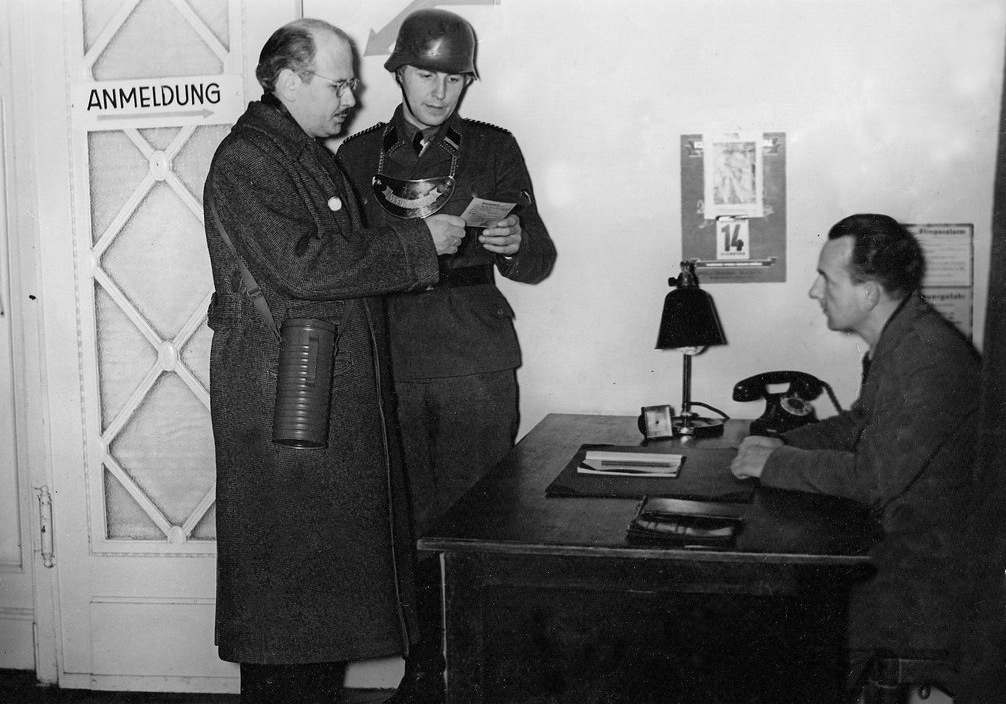
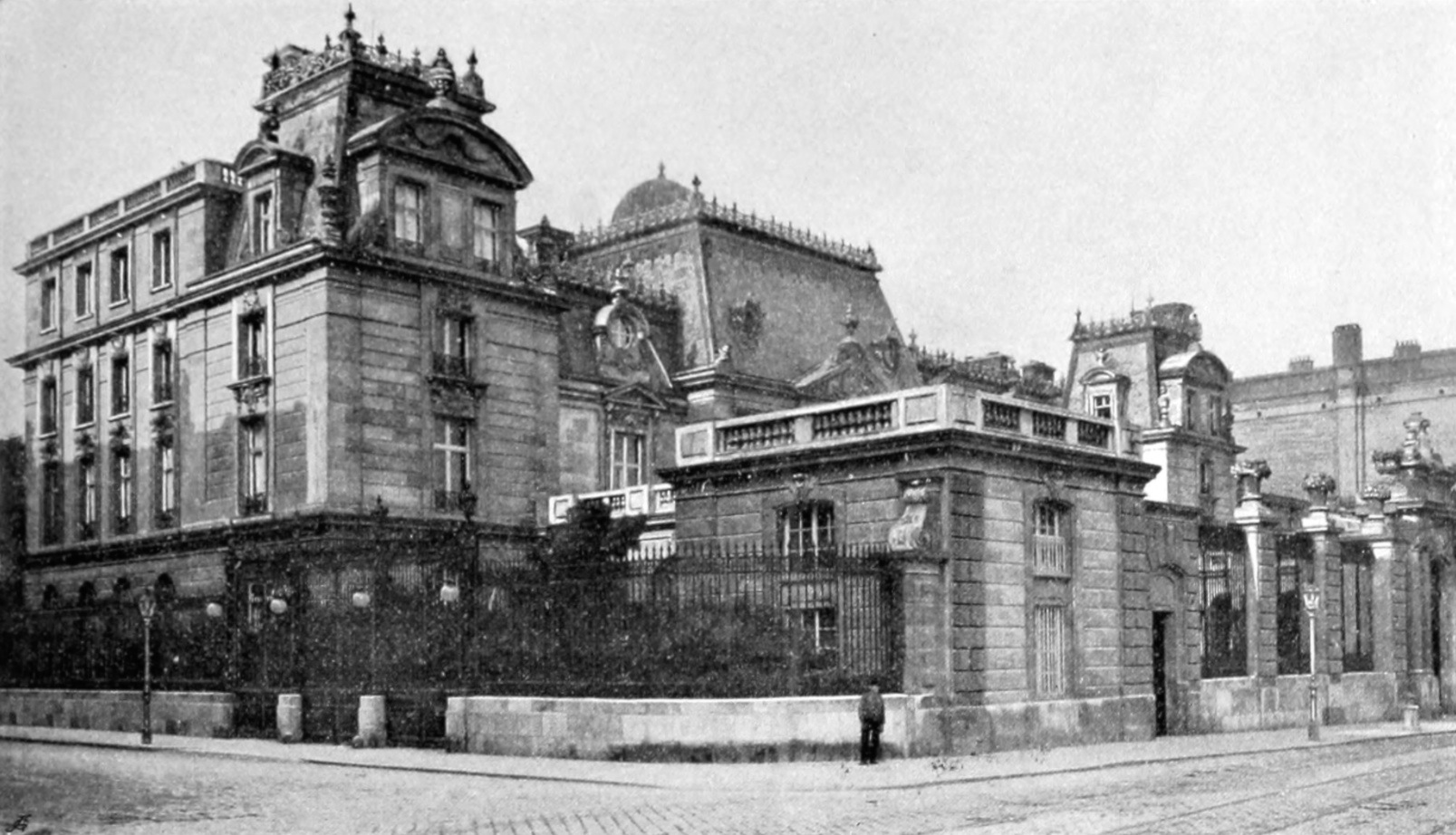
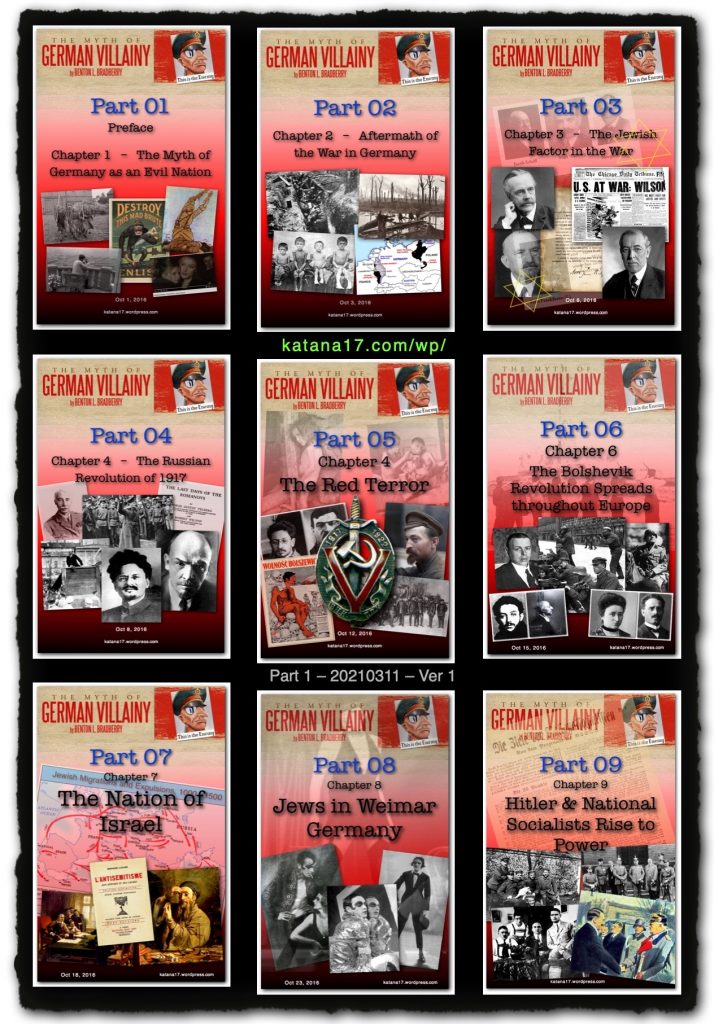
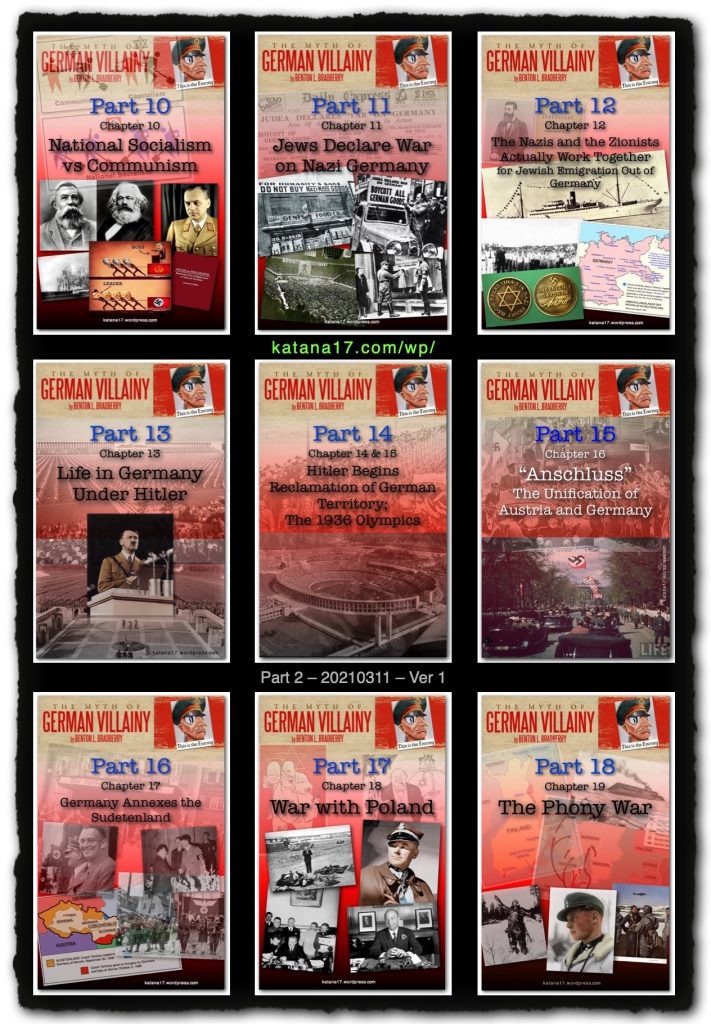
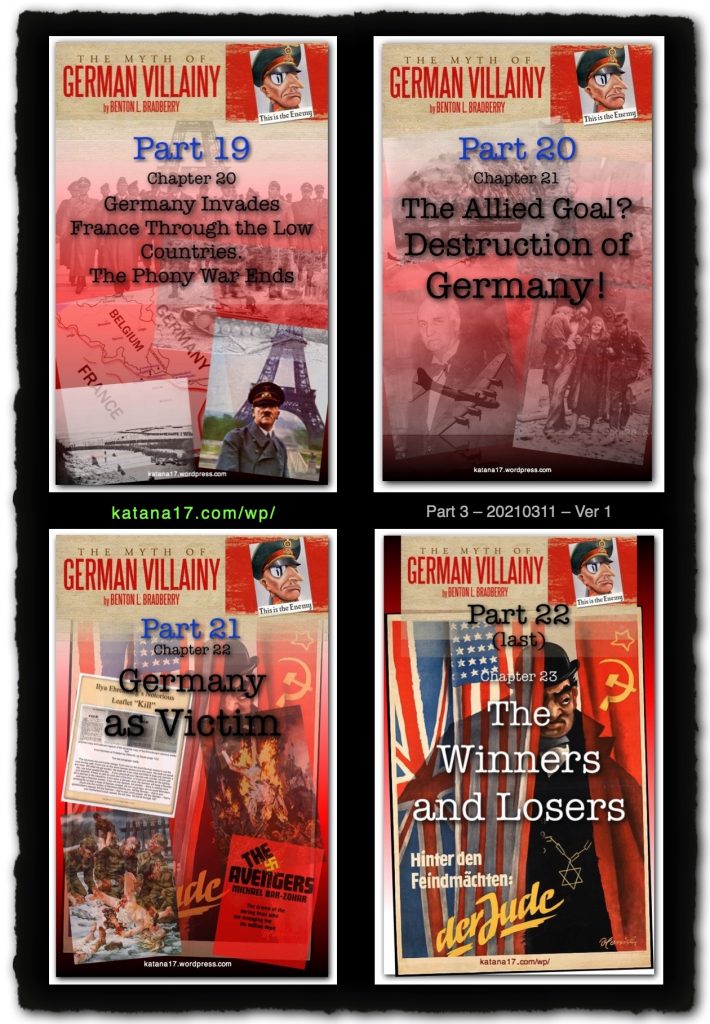
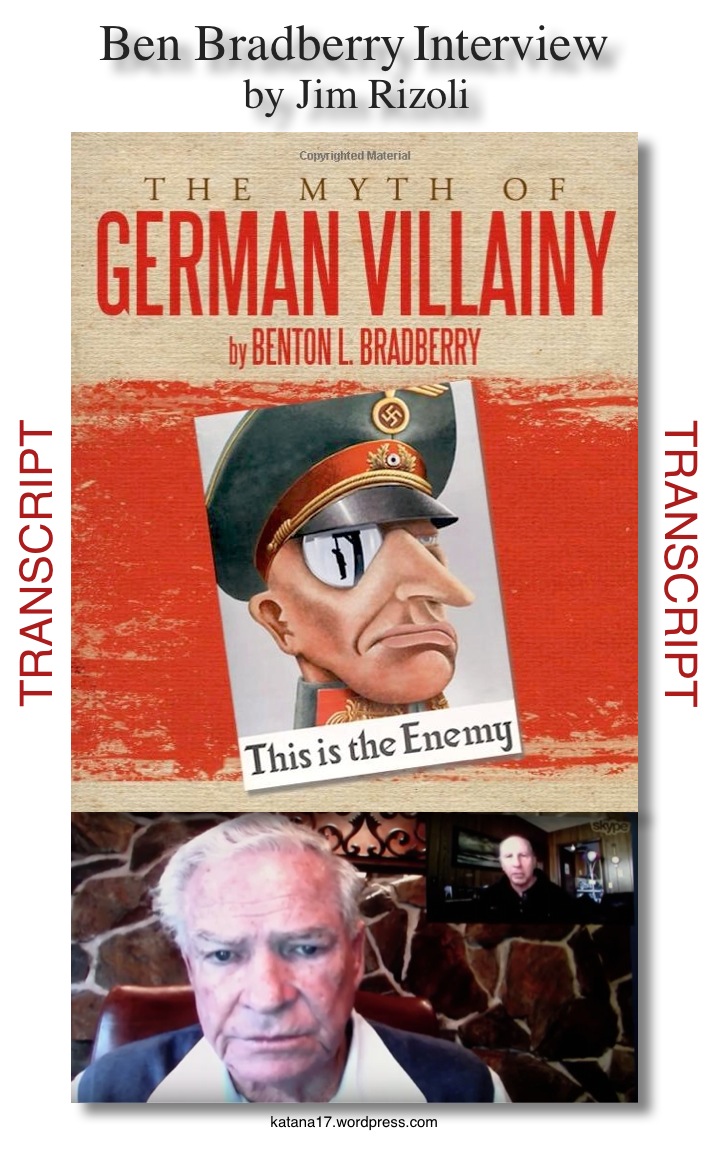
Reblogged this on behindertvertriebentessarzblog.
Tx for singling this one out. Pls., note this one:
http://de.metapedia.org/wiki/Churchill-Stalin-Pakt
If true, it explains really everything… This Plan set off with Finland, then Norway. May or so ’41 was Yugoslavian coup. So south front… etc etc
Totally important and decisive information in my modest view. Know this since 16.4.2016 By pure accudent. It is only confirmed by very limited sources. Mannerheim’s S-32 is the thing. Vilho Tahvanainen passed it on to Erki Hautamaki, who published about it. Also Stalin’s Op. ‘Groza’ in Bradberry’s splendid work is not mentioned. Germany acted every time in total self-defense… I was learned quite the opposite at school. Now 53y of age…
Kind regards, Wouter Kok Netherlands
Op 5 jan. 2017 1:28 PM schreef “katana” :
> Admin posted: ” [Part 15] [Benton Bradberry’s 2012 book, “The Myth > of German Villainy” is a superb, must-read, revisionist look at how the > German people have been systematically, relentlessly and most > importantly, unjustly vilified as the ar” >
Pingback: Book - The Myth of German Villainy - Part 08 - Jews in Weimar Germany - katana17katana17
Pingback: Book - The Myth of German Villainy - Part 04 - The Russian Revolution of 1917 - katana17katana17
Pingback: Book - The Myth of German Villainy - Part 02 - Aftermath of the War in Germany - katana17katana17
Pingback: Book - The Myth of German Villainy - Part 05 - The Red Terror - katana17katana17
Pingback: Book - The Myth of German Villainy - Part 10 - National Socialism vs Communism - katana17katana17
Pingback: The Myth of German Villainy: Author Ben Bradberry Interview — TRANSCRIPT - katana17katana17
Pingback: Book - The Myth of German Villainy - Part 20 - The Allied Goal? Destruction of Germany! - katana17katana17
Pingback: Book - The Myth of German Villainy - Part 18 - The Phony War - katana17katana17
Pingback: Book - The Myth of German Villainy - Part 17 - War with Poland - katana17katana17
Pingback: Book - The Myth of German Villainy - Part 21 - Germany as Victim - katana17katana17
Pingback: Book - The Myth of German Villainy - Part 22 (last) - Winners and Losers - katana17katana17
Pingback: Book - The Myth of German Villainy - Part 03 - The Jewish Factor in the War - katana17katana17
Pingback: Book - The Myth of German Villainy - Part 07 - The Nation of Israel - katana17katana17
Pingback: Book – The Myth of German Villainy by Benton Bradberry – Part 01 | katana17
Pingback: Book – The Myth of German Villainy – Part 16 – Germany Annexes the Sudetenland | katana17